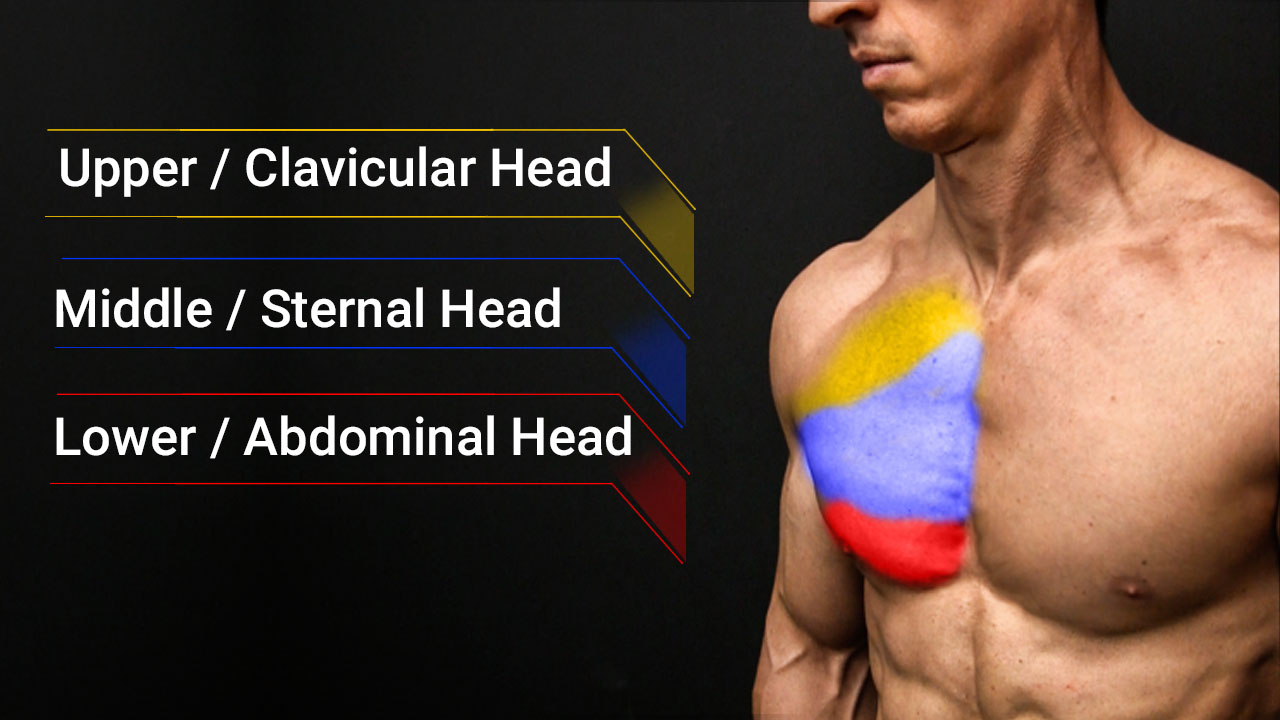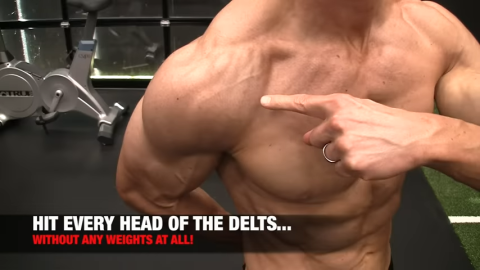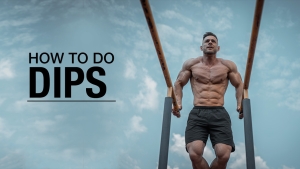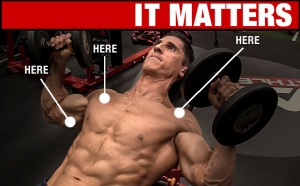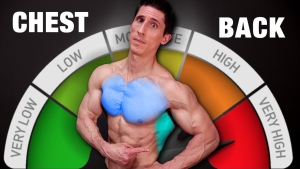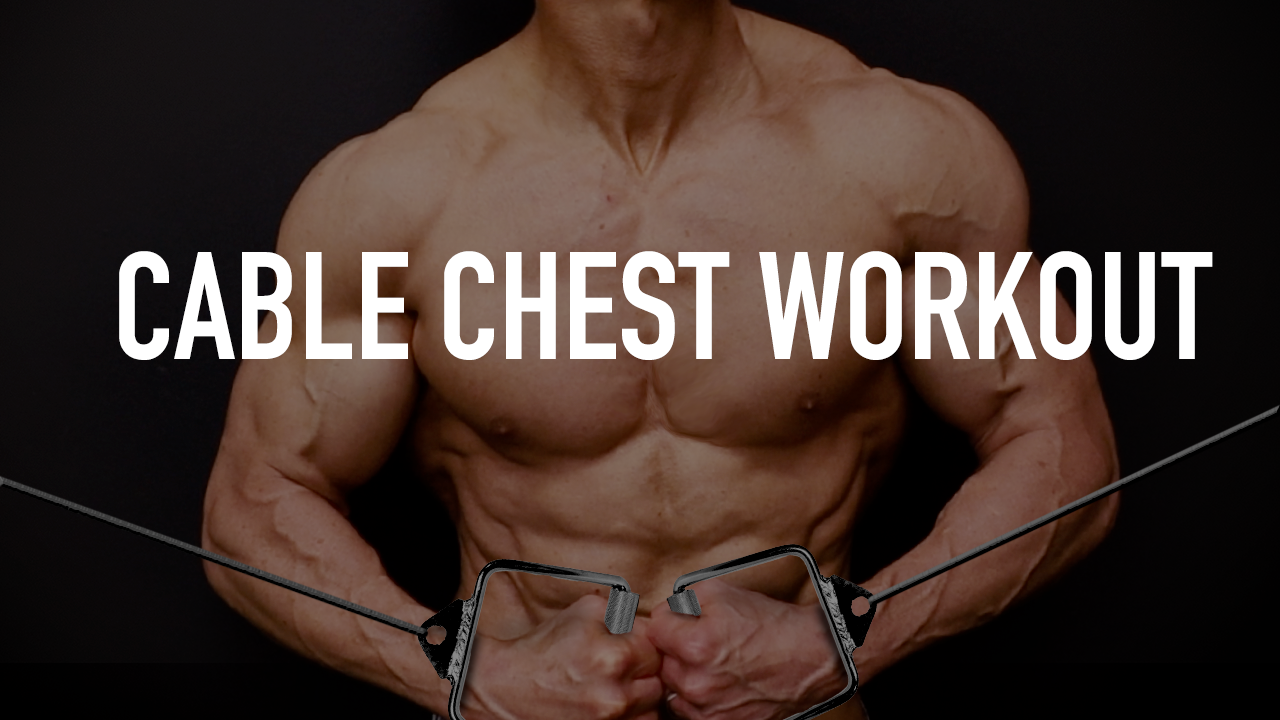
CABLE CHEST WORKOUT
When it comes to chiseling out that defined, athletic chest, dumbbells and barbells might seem like the only equipment game in town but don’t be so quick to judge.
Today, we’re diving deep into the most underrated piece of equipment in your workout arsenal for chest workouts – the cable machine.
The constant tension and variety of angles you can achieve with a cable chest workout could be exactly the game-changer you’ve been looking for.
Whether you’re a beginner looking to spark new growth, or a seasoned lifter hunting for that extra edge, I’m going to show you why you need to be incorporating cable exercises into your chest training regimen.
ANATOMY OF THE CHEST MUSCLES
Before we dive straight into the nitty-gritty of the cable chest workout, we need to take a step back.
Because understanding the anatomy of the chest is KEY. If you’re going to train like an athlete, you’ve got to think like one, and that means knowing exactly what primary movers you’re working with.
We’re not just blindly moving weights here. We’re targeting specific muscles to sculpt that powerful, athletic chest we all want.
By understanding the origin and function of the chest muscle fibers, you can see why certain angles and cable chest exercises can maximize the activation and growth of the chest.
Cables provide constant tension for the entire exercise, providing an excellent workout for a fully developed chest.
So, let’s break down the major muscles in the chest, and see how we can hit them effectively with cables.
PECTORALIS MAJOR VS PECTORALIS MINOR
The chest is made up of two crucial upper body muscles: the pectoralis major and the pectoralis minor.
When we talk chest, most guys immediately think of the pec major. This is that beefy, broad muscle stretching from the collarbone all the way down to the lower sternum, wrapping around to your arm.
When you’re hitting those Bench Presses or Push-Ups, this is the muscle you’re working.
Underneath the pec major, tucked away, is the pec minor. Think of these secondary muscles as the little brother – smaller, sure, but pulling its weight in the background.
Running from ribs three to five and anchoring on the scapula, it’s a key player in stabilizing those shoulder blades and even helping you breathe deep when you’re pushing your limits.
For our purposes, we’re going to focus on the direction of the muscle fibers that make up the pecs: upper, middle (horizontal), and lower.
UPPER CHEST FIBERS (CLAVICULAR HEADS)

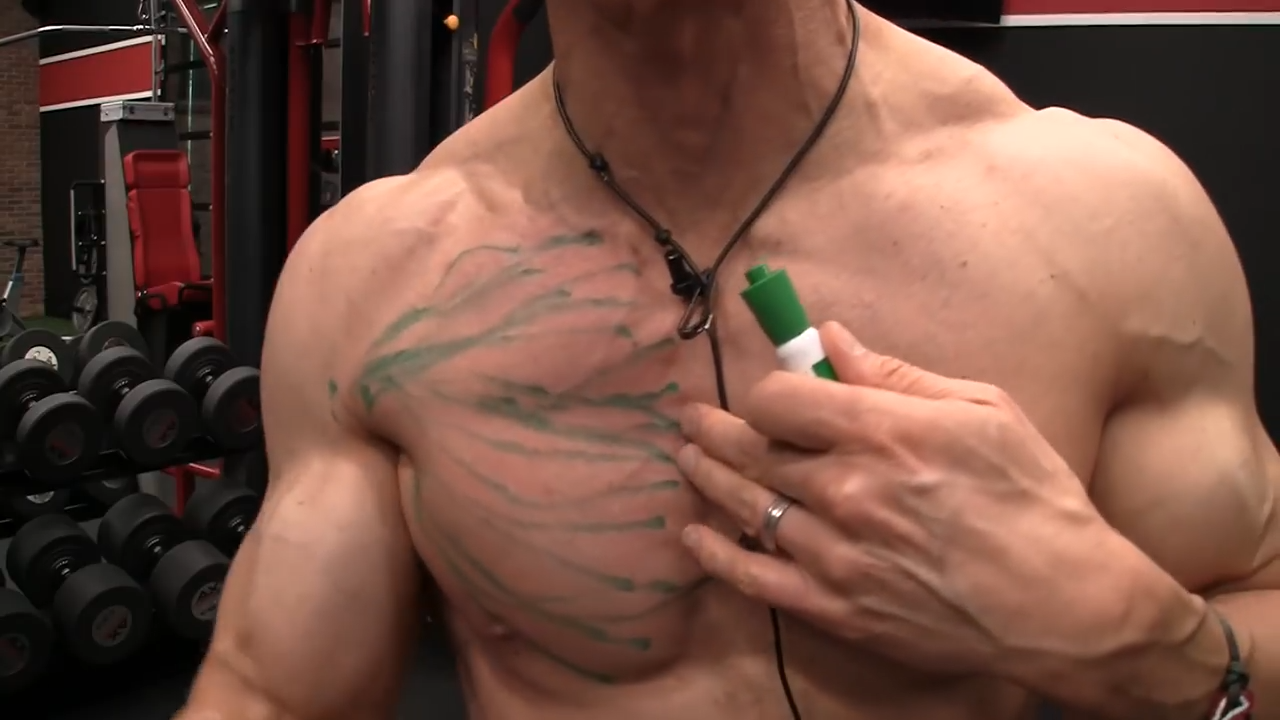
The clavicular heads of the pectoralis major – better known as the upper chest fibers – start at the medial half of the clavicle, which is basically the collar bone. Hence, the name “clavicular head.”
The primary functions of the clavicular head are:
- Flexion of the Humerus: This means bringing your arm upwards in front of you, like when you’re reaching up to grab something from a high shelf.
- Horizontal Adduction: Imagine giving someone a big bear hug. Those upper chest fibers are hard at work, helping to bring your arms across the body.
- Internal Rotation: This involves rotating the arm inwards, towards the center of your body. An easy way to think of it is turning a doorknob clockwise with your right hand.
The Cable Incline Bench Press and Incline Cable Fly is a great way to target the fibers of the upper chest.
MID CHEST FIBERS (STERNAL HEADS)


Next up, we have the midline muscles of the chest. The sternal heads of the pectoralis major are what most of us envision when we think about a strong, muscular chest.
These muscle fibers originate from the sternum, which is the breastbone running down the center of your chest, and the upper six costal cartilages, connecting the ribs to the sternum. This larger origin gives the mid chest its substantial, thick appearance.
The main functions of the midline muscles of the chest include:
- Horizontal Adduction: Just like the upper chest, the mid chest fibers also play a significant role in movements where you bring your arm across the front of your body. Think about the finishing motion of a Cable Chest Fly or Dumbbell Flys, for example.
- External Rotation: Opposite to the upper chest, the mid chest fibers help in rotating your arm outwards. If you’re mimicking the action of turning a doorknob counterclockwise with your right hand, you’re engaging these fibers.
- Extension of the Humerus: This involves bringing your arm down from a raised position to your side. Think about the downward motion when doing a dip or lowering your arms after a raise.
Given their central location and function, the mid chest fibers are the primary workhorse during many classic chest press movements like Dumbbell Flies, Stability Ball Chest Presses, and Dumbbell Presses.
LOWER CHEST FIBERS (ABDOMINAL HEADS)

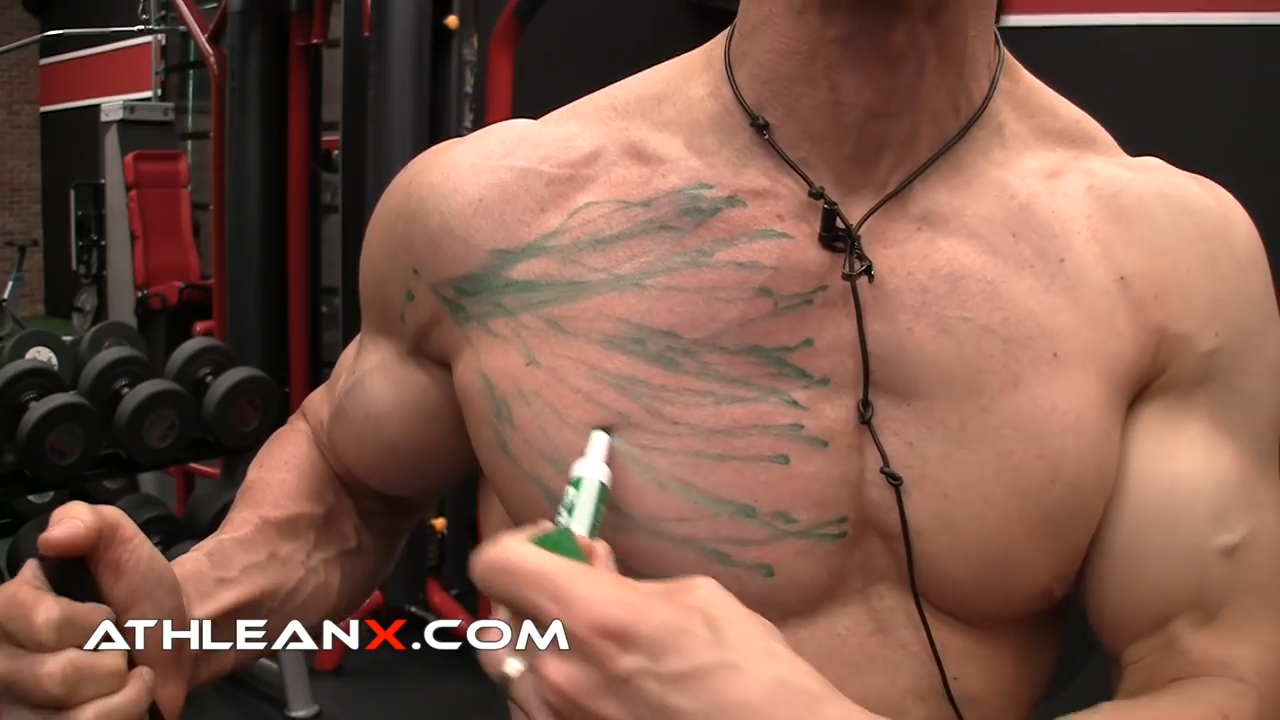
Finally, we have the lower major fibers of the chest, also referred to as the abdominal heads of the pectoralis major.
The lower chest muscle fibers originate from the anterior layer of the rectus sheath and the external obliques. This is the fascia surrounding our core muscles, which makes the lower chest fibers’ origin slightly different than its upper and mid counterparts.
Here’s what this part of the chest muscle is responsible for:
- Depression of the Humerus: This involves actively pulling the upper arm bone downward. An easy way to visualize this motion is to think about the act of pressing down during a dip exercise, where the lower chest fibers actively engage to drive the movement.
- Horizontal Adduction: Just like the other parts of the chest, the lower chest fibers are also responsible for bringing the arm across the body. This action becomes even more pronounced at angles that emphasize the lower chest, like Cable Decline Bench Chest Presses or Decline Cable Flys.
- Internal Rotation: Similar to the upper chest fibers, the abdominal heads play a role in the internal rotation of the humerus. When the arm rotates inward towards the center of the body, these fibers are active.
ANTERIOR DELTS (FRONT DELTS)
Although the anterior deltoids are not inherently part of the chest muscles, their engagement is unavoidable in most exercises targeting the chest.
Shoulder control and deltoid development are pivotal aspects of upper body strength and aesthetics.
Positioned at the front of your shoulders, these muscles play a primary role in shoulder flexion. This refers to the motion of bringing your arm forward or across your body.
BEST CABLE CHEST EXERCISES
Now that we’re through with the anatomy lesson for the chest, it’s time to cover the best cable machine chest exercises.
Aside from learning how to develop a solid mind-to-muscle connection, I wanted you to learn about these muscle fibers because each of the cable exercises I’ve selected targets one of the three sections.
We’re going to start with the upper chest muscle fibers and work our way down. Let’s go!
HIGH TO LOW CABLE CROSSOVER


HOW TO DO HIGH TO LOW CABLE CROSSOVERS:
- Start by positioning yourself between a cable machine with the pulleys set to the highest point. Grab the handles with overhand grip6**.
- Take a step forward, get into a staggered stance with one foot ahead of the other to give you stability.
- Extend your arms out to the side, in line with your shoulders, and keep a slight bend in your elbows. You should feel a good stretched position in your chest.
- Now, initiate the movement by contracting the chest and bringing the cables at a downward angle and in front of you. As you bring those handles together, let your hands and wrists CROSS OVER one another. This small tweak ensures maximum contraction in the pecs.
- After each rep, make sure to alternate which hand goes over the top, so both sides get equal stimulation.
- Slowly return to the starting position, controlling the heavier weights and feeling the stretch in the chest, but don’t let the weight stack touch. Maintain tension in the muscles.
WHAT MAKES IT EFFECTIVE: When you cross your hands and wrists over one another, you’re pushing the upper muscle fibers into their complete range of motion.
CABLE BENCH PRESS

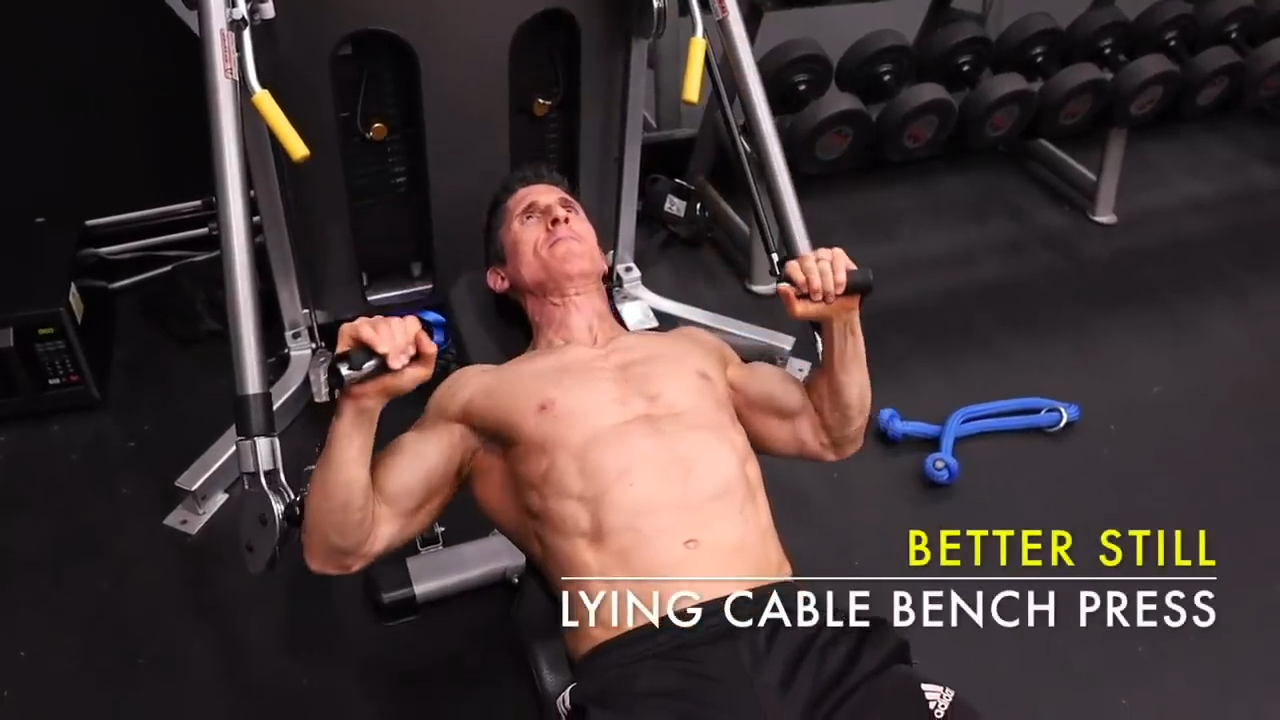
HOW TO DO CABLE BENCH PRESSES:
- To do cable presses, position an adjustable bench in between the two columns of a cable machine. Ensure the pulleys are set to about chest height or slightly lower when seated. While you might be tempted, avoid using heavy weights right away. Go with something moderate.
- Start from a seated position on the weight bench and grab the cable handles. Lie back with your feet flat on the floor, a natural arch in your lower back, and shoulder blades squeezed together for a stable base.
- Start with your hands directly over your chest, elbow position is slightly bent, palms facing forward. Your arms should be in line with the cables, ensuring a straight pull and no unnecessary strain on the shoulders.
- Engage the chest and press the handles straight up towards the ceiling. Imagine you’re trying to push the two cables together. This will optimize chest activation.
- Control is key here. Slowly lower the handles back to the starting position (90-degree angle with the elbows), feeling a good stretch in the pecs.
WHAT MAKES IT EFFECTIVE: With cables, the resistance remains consistent, so you can make use of that tension to build chest strength and muscle during this compound movement. Using an incline bench would focus more on the upper muscle fibers. Performing this as a Cable Narrow Press, would engage the triceps more. And if you want to throw in a stability challenge, try this on an exercise ball.
HORIZONTAL CABLE CROSSOVER

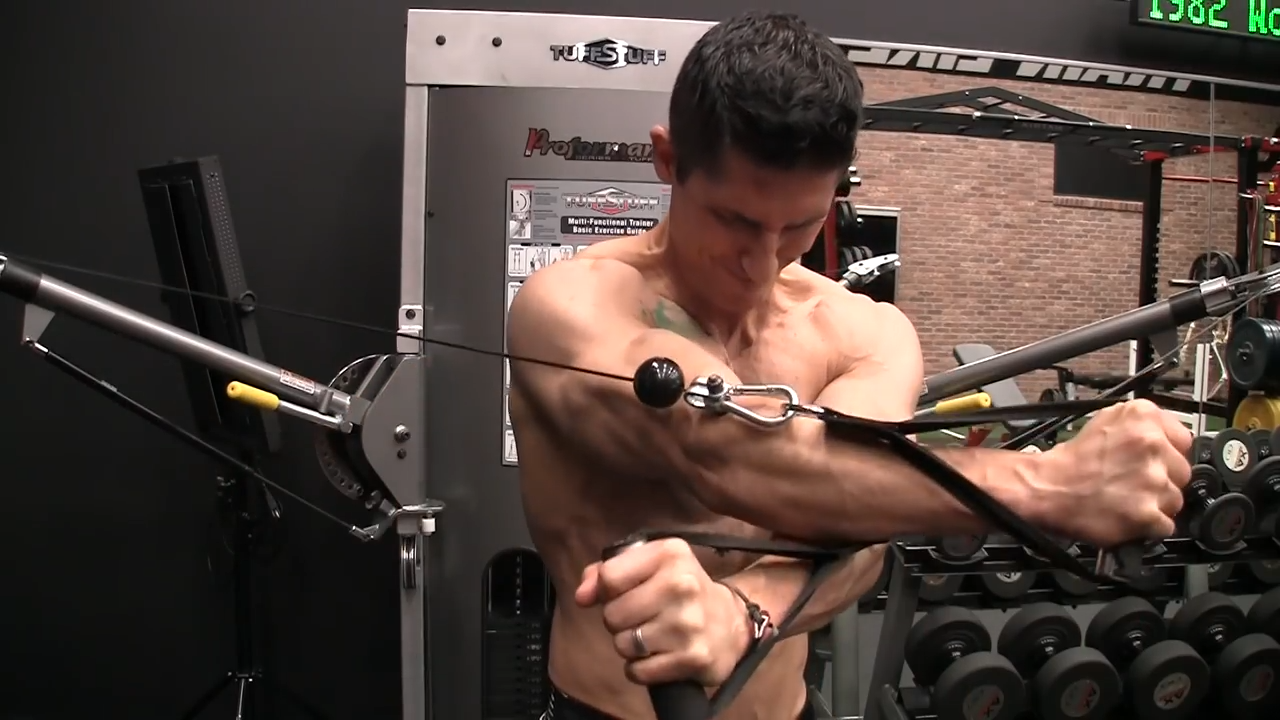
HOW TO DO HORIZONTAL CABLE CROSSOVERS:
- Start with the pulleys set to a mid-level position on a Cable Crossover machine – right around shoulder height. You’ll need a handle attached to each pulley.
- Position yourself in the center of the cable tower, standing tall with a slight bend in your knees for stability. Your feet should be in a shoulder-width stance. This solid foundation ensures you’re isolating the chest without relying on momentum.
- Grab the handles with an overhand grip (palms facing downward). Begin with your arms outstretched to the sides and slightly forward. Keep a slight bend in the elbows at shoulder level.
- Always start the movement with the chest muscles. Visualize squeezing a pencil between your pecs to help in activating the chest from the outset.
- Slowly bring the handles together in front of you, ensuring you’re getting a peak contraction of the chest muscles as they meet. The movement should resemble giving a big hug.
- As you return to the starting position, control the resistance to prevent it from pulling your arms back too abruptly. The controlled release (eccentric portion) is vital for muscle development.
WHAT MAKES IT EFFECTIVE: I’ve come across some folks who swear by the Horizontal Cable Crossover, arguing that, based on EMG studies, it might even surpass the Flat Bench Press and the Flat Bench Dumbbell Fly in terms of chest activation.
SINGLE-ARM CABLE CROSSOVER


HOW TO DO SINGLE-ARM CABLE CROSSOVERS:
- Set the cable pulleys at the high position. Stand sideways to the cable machine with feet shoulder-width apart. You can opt for a split stance if it helps you stabilize. Your active arm (the one doing the crossover) should be nearest to the machine.
- Using a single handle attachment, grab the handle with your active arm. Before initiating the crossover, make sure you pull the cable slightly back. This ensures better engagement of the chest muscles from the start.
- As you initiate the movement, turn your torso slightly away from the machine. Simultaneously, “punch” or extend your arm diagonally across your body, while keeping a slight bend in your elbow. Your hand should move in the direction of the opposite foot. The rotation of the torso combined with the arm movement ensures maximum chest muscle activation.
- Maintain a tight core throughout the movement for stability and to prevent any unnecessary movement in the spine.
- Slowly return to the starting position, resisting the pull of the weight.
WHAT MAKES IT EFFECTIVE: By slightly pulling back and then punching forward and across your body, you’re maximizing the natural range of motion in this exercise. This is an excellent unilateral exercise for correcting muscle imbalances as well.
INNER CHEST X-CROSS


HOW TO DO INNER CHEST X-CROSS:
- Begin by selecting a lighter weight on the cable pulley machine. Adjust the pulleys to a lower position, just below the hips.
- Position yourself in the center of the cable towers with your feet shoulder-width apart. Keep a slight bend in your knees and engage your core to maintain stability throughout the movement.
- Reach down and grab the handles with a neutral grip and your arms extended at your sides. Point your thumbs in toward one another.
- Begin by pulling the cables toward each other with your thumbs leading the way. Focus on pulling with your chest muscles as your thumbs move across one another.
- Alternate which hand/wrist is on top with each repetition to ensure balanced muscle engagement on both sides.
- Slowly release the cables back to the starting position in a controlled manner, resisting the pull of the weight.
WHAT MAKES IT EFFECTIVE: This cable crossover alternative is fantastic for targeting the inner portion of your pec muscles. Whether you use this for a beginner workout or a finisher movement in an advanced workout, this exercise will help you make continued progress.
LOW TO HIGH CABLE CROSSOVER

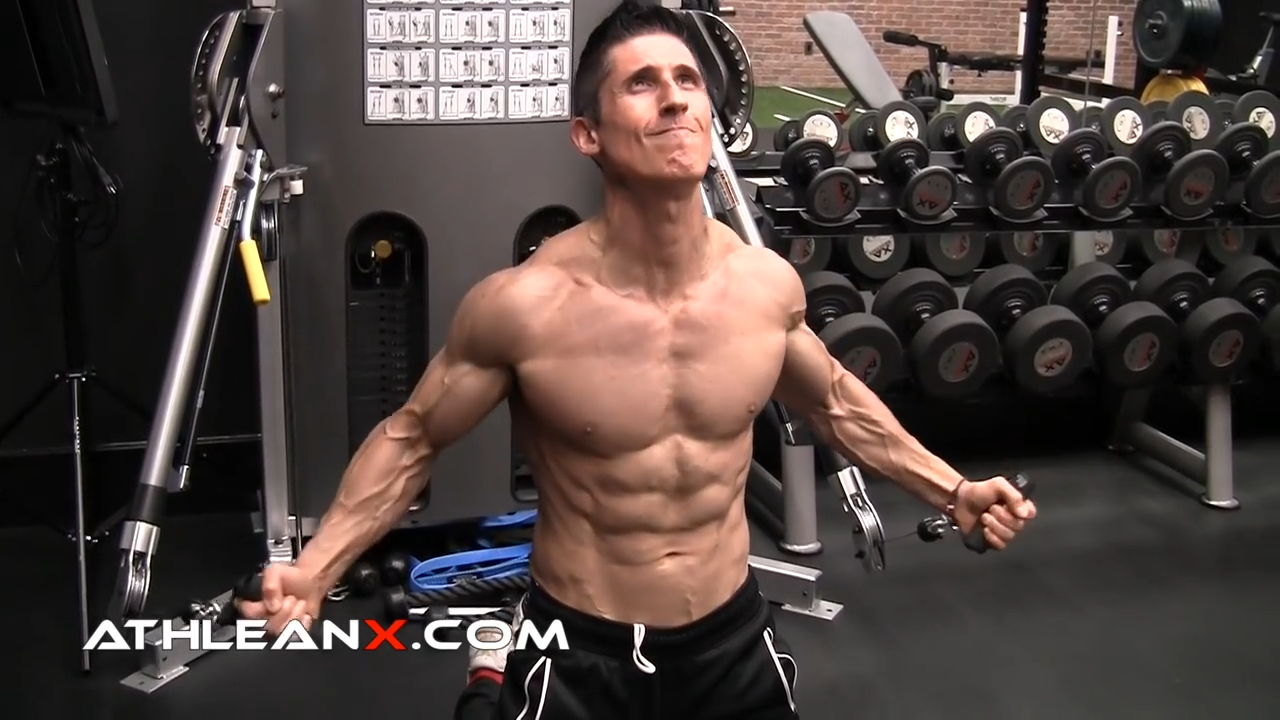
HOW TO DO LOW TO HIGH CABLE CROSSOVERS:
- Get those cables set to the bottom, or just slightly above it. Stand right in between those twin cable towers. Get your feet shoulder-width apart. Remember, stability starts from the ground up, so firmly plant those feet!
- Reach down and grab the handles with an underhand grip. When you start, your hands should be down by your sides. Your palms should be facing forward, and arms should be slightly behind you.
- Initiate that pull by driving your hands upwards and slightly inwards, following that low-to-high arc pattern. Think about the motion you’d make if you were trying to scoop something up from the ground and throw it over your shoulder.
- Don’t just stop when your hands meet in the middle. Push past that point! Extend those arms upward to upper chest level, ensuring your hands and wrists cross over one another.
- Don’t just let those weights drop back down. Slowly lower the cables back to the starting position.
- Alternate which hand / wrist is on top as you move from rep to rep.
WHAT MAKES IT EFFECTIVE: In the starting position of this chest cable pull, you’re already pre-activating your lower pec muscle fibers. As you push up, you’re taking the muscle through a complete range of motion and into full contraction.
OMNI CROSSOVERS

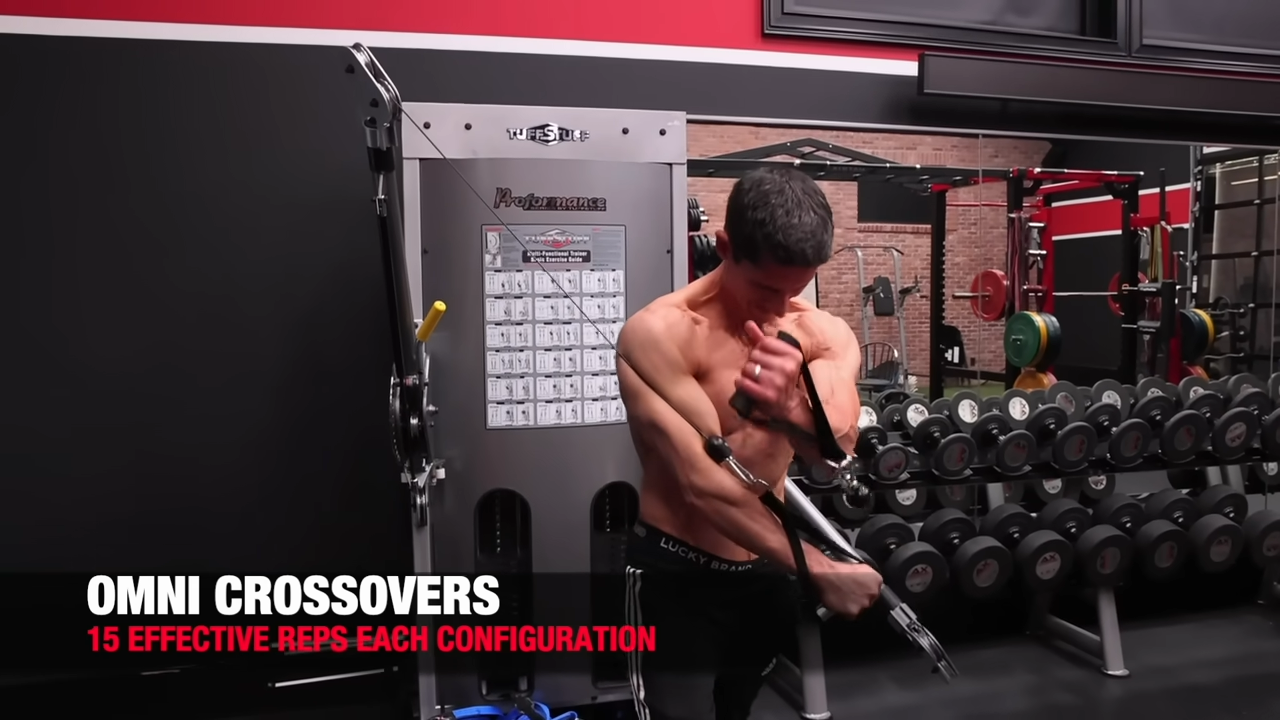
HOW TO DO OMNI CROSSOVERS:
- Adjust the weights based on the motion. When pulling from top to bottom, increase the weight by 20% to 40% more than the bottom-to-top motion. This accounts for the fact that when operating from top down, the upper chest muscles are naturally weaker than the lower chest muscles. So, adjust your weight stack to compensate.
- Position one cable at a high setting and the other at the lowest level setting. Get into a staggered stance in between the cable towers.
- For the cable set low, pull it upward and across your body. This effectively targets the upper chest.
- For the cable set high, draw it downward and across your body. This will primarily engage the lower chest.
- Once you’re done, swap the positions of the cables. Change the previously high cable to the lowest position and vice versa. Repeat the exercise sequence, ensuring you’re targeting both chest regions effectively.
WHAT MAKES IT EFFECTIVE: The type of movement with cable pulls offers a unique and comprehensive approach to chest training by targeting different portions of the pectoral muscles through varied angles and resistance.
CABLE CHEST WORKOUT FOR MUSCLE GROWTH
Whether you want a bigger and more shredded chest, it’s important to go back to the basics and cover the fundamental principles of muscle growth.
The well-rounded chest workouts I provide below are specifically designed to optimize muscle recruitment for hypertrophy.
But first, let’s start with the acute variables for your training goals and what you need to know to grow on your fitness journey.
When we talk about acute training variables, we’re referring to those specific components of a workout that can be adjusted and manipulated to influence muscle adaptation and growth. Understanding these variables is pivotal to getting the chest gains you desire.
SETS AND REPETITIONS
The foundation of any resistance workout routine, sets and repetitions dictate how many times you’ll perform a specific exercise and how many repetitions you’ll do in each set.
For hypertrophy training, focusing on a moderate number of sets with a repetition range that challenges the muscle to near fatigue is key.
In general, you’ll want to aim for 3 to 4 sets and a rep range of 8 to 12 repetitions while using a moderate weight – something around 65% to 75% of your one-repetition maximum for that exercise.
INTENSITY
It’s not just about how heavy the weight is but how hard the set feels. Intensity can be gauged by the proximity to muscular failure.
The correct weight to increase intensity really depends on how you’re moving through the set. You can use light weights but if you’re focusing on an intense contraction or using a training partner for negative reps, the intensity will be off the charts. You can even perform bodyweight training with high levels of intensity!
For muscle growth, working at intensities that bring you close to, but not always to, failure can be beneficial.
TEMPO
Continuing with the idea above, the speed at which you perform each rep matters as it can directly impact the intensity you feel.
Slower eccentrics (the lowering phase) can increase muscle time under tension—a crucial factor for the hypertrophic experience.
REST TIME INTERVALS
For hypertrophy training programs, shorter rest time periods (around 60-90 seconds) between sets can be effective. This allows for just enough recovery to hit the next set hard, but not so much that intensity drops off.
FREQUENCY
This pertains to how often you train a muscle group. When working with cables, the controlled movement allows for potentially more frequent training sessions without the risk of overtraining.
If your goal is to grow your chest, I’d recommend hitting the chest twice per week.
With that said, here are two cable chest workouts you can follow each week. Since there are no more than 12 total sets, you can feel free to add in other exercises such as shoulders, arms, and core.
WORKOUT 1
- Cable Bench Press: 3 to 4 x 8 to 12 repetitions
- Single-Arm Cable Crossover: 3 x 12-15 reps
- Inner Chest X-Cross: 2 x Failure (do as many as you can)
- Low to High Cable Crossover: 3 x 8-12 reps
WORKOUT 2
- High to Low Cable Crossover: 3 to 4 x 8 to 12 repetitions
- Horizontal Cable Crossover: 3 x 12-15 reps
- Inner Chest X-Cross: 2 x Failure (do as many as you can)
- Omni Crossovers: 3 x 8-12 reps
When you want to build up your chest, it’s easy to overlook the cable pulley machine, especially if you’ve only ever used it for isolation movements in the past.
Cable machines maximize muscle activation while moving through the entire range of motion, making them perfect for both stronger muscles and muscle growth.
Are you looking for more than a chest day workout – maybe a complete cable workout program? We’ve got you covered! Check out our ATHLEAN-X programs to see which is the best fit for your goals and fitness level.

- For those seeking a sculpted, athletic chest, it’s easy to default to traditional dumbbells and barbells. However, cable chest workout routines offer distinct advantages due to their continuous tension and the unique angles achievable.
- To properly engage the chest with the right exercises, it’s important to understand the muscle fiber directions: upper, middle (horizontal), and lower:
- The upper chest fibers originate from the medial half of the collar bone. To effectively target these fibers, consider exercises like Horizontal Cable Crossovers, Single-Arm Cable Crossovers, Low to High Cable Crossovers, and Omni Crossovers.
- The mid-chest muscle fibers originate from the sternum – the central breastbone – and the area that connects the ribs to the sternum. To hit these mid chest fibers, incorporate exercises like Bench Cable Presses, Horizontal Cable Crossovers, and Single-Arm Cable Crossovers into your cable workout routine.
- The lower chest fibers have an origin from the core’s fascia and can be targeted with exercises like the High to Low Cable Crossover, Inner Chest X-Cross, and Omni Crossovers.
- To achieve a larger and more defined chest, it’s crucial to understand and apply the fundamentals of muscle growth, with a focus on acute variables that influence muscle adaptation:
- Key components include sets and repetitions (3-4 sets of 8-12 reps at 65%-75% of one-repetition max), intensity (close to muscular failure), tempo (slower lowering phase for more muscle time under tension), rest intervals (60-90 seconds), and frequency (training the chest twice a week).
CABLE CHEST WORKOUT FAQS
When it comes to chest workouts, many jump straight to thinking about the Bench Press or Dumbbell Presses. And while there's no denying their importance, cables offer a distinct advantage and a unique experience.
One of the primary benefits of cable chest workouts is the continuous tension they maintain throughout the entire movement. From start to finish, your chest is actively engaged.
Additional benefits include the versatility of cables. You can target the chest from a variety of angles, ensuring a well-balanced workout. They also allow for a more natural, arcing movement that isn't just joint-friendly but also mirrors the functional path of motion we use in our day-to-day lives.
When using cables, it's also easier to harness that crucial mind-muscle connection, enabling you to really hone in on the muscle and its movement. So, in short,6 cables are a fantastic addition to any chest workout.
You can absolutely build a bigger chest with cable machine exercises. Cables are different in that they constantly keep tension on the muscle throughout the ranges of motion. This means from the start to the finish of each rep, your chest is under load, optimizing muscle fiber recruitment.
As long as you are moving with control and avoiding momentum, your muscle building workouts will be just as good – if not better – than using dumbbells and heavy barbells.
One of the things I love about cable workouts is that they allow for more controlled movements and versatile angles, ensuring you hit every part of your pecs.
So, if you're looking to add size and definition to your chest, don't overlook the effectiveness of cable workouts.
"Better" is a relative term. Cables have their advantages – mainly consistent tension for optimized muscle fiber recruitment. This continuous tension can lead to a better pump and potentially more muscle growth.
However, traditional free weights also have their place. They help in building foundational strength and can engage stabilizer muscles to a greater degree.
So, instead of thinking in terms of "better," consider the benefits of each and how they can fit into your overall training strategy.
My advice? Incorporate both. Diversify your chest workouts by mixing in free weights and body weight with cable exercises. It's all about striking a balance and leveraging the best of both worlds.
Cables are an incredible tool because they provide tension throughout every inch of the movement. Here are some tips on how you can effectively train your chest using cables:
- Form: Remember, form is crucial. Stand tall, chest out, and shoulders back. Get a good grip on the handles and position yourself in the center of the cable towers.
- Range of Motion: Execute a full range of motion. If you're doing a Cable Fly, for example, stretch your chest at the beginning and squeeze the pecs hard at the end of each rep.
- Tempo: Control is key. Use a slow and controlled motion, especially on the eccentric (or lowering) phase. This increases time under tension, which is crucial for muscle growth and stronger muscles overall.
- Exercise Variations: Don't just stick to one movement. Mix in Cable Chest Presses, Single-Arm Crossovers, and various angles of Cable Flies to target every part of your pecs.
- Volume & Intensity: Remember, it's not just about moving the weight. Push yourself and aim for muscle fatigue towards the end of each set, but always prioritize form over weight.
Unlike dumbbells or barbells, where there might be certain 'rest' points in the lift, cables don't let up. This continuous tension demands more from your muscles, especially your pecs, every single inch of the way.
Secondly, stabilization is key with cables. The cables want to pull you in the direction of the weight stack, requiring not only your chest but also your core and other stabilizer muscles to engage more actively. It's an entire body effort!
Another point is the range of motion. Cables allow for a deeper stretch and a more pronounced deep pec contraction of the chest, making the exercise feel tougher as you're engaging the muscle fibers more intensely.
So yes, the Cable Chest Press might feel tougher, but remember, with greater challenge comes greater reward. As always, focus on proper form to avoid injury and maximize your results.
Now, at first glance, this might seem counterintuitive because Cable Rows primarily target the muscles of the back, specifically the lats, rhomboids, and traps.
However, here's where it gets interesting. While the primary function of a Cable Row isn't to work the chest, the exercise does play an indirect role in chest development.
How? It's all about balance and posture.
By strengthening the muscles of the upper and middle back, you help to counteract the effects of your often hunched-forward posture. A strong back pulls your shoulders back, improving shoulder stability, and it allows for better chest activation in your pushing exercises. Think of it as setting the stage for better chest workouts.
That being said, if your primary goal is chest development, you'll want to focus on exercises that directly target the pecs like Cable Chest Presses, Cable Straight-Arm Pullovers, and Regular Cable Flys.
The pulley height of the cables largely depends on the specific exercise you're performing and the portion of the chest you're targeting.
- For Upper Chest: If you're doing a Low-to-High Cable Fly, you'll want to set the pulleys at a lower position, typically starting just below your hips. This allows you to target that upper pectoral region as you fly upwards and inwards.
- For Middle Chest: For standard cable chest flies or presses, adjust the pulleys to be about chest height. This aligns with the fibers of the mid - chest and provides optimal tension.
- For Lower Chest: High-to-Low Cable flies target the lower pecs. Here, you'll set the pulleys at a higher position, often above your head, so you can pull the cables downward and across your body.
Remember, the key is to align the direction of the cables with the fibers of the specific chest area you're looking to target. Always ensure you're using proper form and focusing on a good stretch and strong contraction with every rep.
REFERENCES

Jeff Cavaliere M.S.P.T, CSCS
Jeff Cavaliere is a Physical Therapist, Strength Coach and creator of the ATHLEAN-X Training Programs and ATHLEAN-Rx Supplements. He has a Masters in Physical Therapy (MSPT) and has worked as Head Physical Therapist for the New York Mets, as well as training many elite professional athletes in Major League Baseball, NFL, MMA and professional wrestling. His programs produce “next level” achievements in muscle size, strength and performance for professional athletes and anyone looking to build a muscular athletic physique.
















